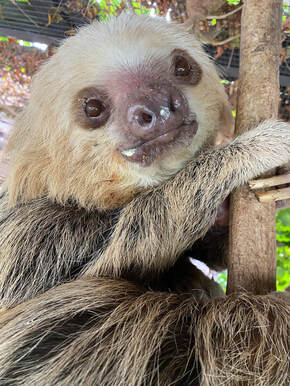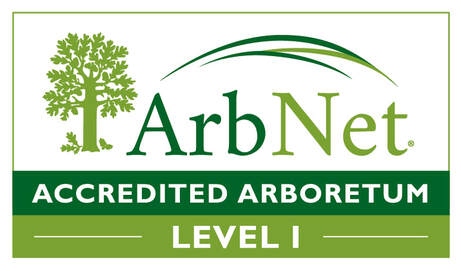 Photo By: Emma Carney Photo By: Emma Carney Written By: Jen Farrell Last week was Wolf Awareness Week, this week is Bat week, we celebrate our animals with such a fast pace. Allow me to help slow things down. Friday, October 20th was International Sloth Day! Being late to the party as the calendar hits October 26th, it seems to be in good fashion to take our time and introduce the slowest mammal on the planet. Divided between two families of three-fingered to two fingered Sloths, there are currently six living species. At Connecticut’s Beardsley Zoo we have two-toed Sloths known as the Hoffman’s Two-toed Sloth. We affectionately know them as Hope (b.1993) and Rhubarb (b.1990). Both live in our Rainforest Building and serve as ambassadors for their kind, in addition to being genetically valuable individuals in the Association of Zoos & Aquarium’s Species Survival Plan. We are all familiar with the word “sloth”, after all it is one of the seven deadly sins. To be a sloth defined from Middle English translates to laziness, to be unwilling to put forth effort, to avoid responsibility. At the time of mid-18th century (before Darwin’s Origin of Species) naturalists of the time saw these traits in the tree dwelling mammals we all know and love and determined that this meant the Sloth was among the “lowest forms of existence”. Ouch…
Little did they know, Sloth’s have lived on this planet for upwards of 64 million years. The adaptive features that contribute to their slower pace are: poor eyesight, consuming a folivorous diet, and low metabolism. So, how have they survived so long? If you cannot run, you can certainly hide! Sloths are living, breathing mini- ecosystems. Within the micro-cracks on the outer layer of their double layer fur coat, algae grows with ample moisture present. This gives Sloths in the wild their green coloration. This mutualistic relationship gives them an advantage, by providing camouflage in the rainforest canopy. Additionally, being covered in algae that is native to the rainforest will subsequently make you smell like the rainforest. Any predators that rely on scent to hunt may not be aware of the Sloths presence, as they smell like the habitat all around them. Aside from supporting over 80 different species of algae and fungi, there are various species of moths and beetles that cannot be found anywhere else on earth except from within the fur of a Sloth. Lastly, if you move slower than the speed with which it takes a predator’s vision to register your existence, then all these features will make the perfect recipe for survival. Despite having survived for millions of years, Sloths today face many challenges. Human-influenced threats such as: Rainforest fragmentation, electrocution from power lines, feral dog attacks, road collisions, and removal from the wild to fulfill the demand for the pet trade or tourist interactions have all led to placing these creatures in a very vulnerable spot. Currently two out of the six species have an IUCN status ranging from vulnerable to critically endangered. Fortunately, there are organizations here and abroad that strive to protect and conserve. The Sloth Conservation Foundation is one of them! SloCo (for short) began its mission in 2017 to protect Wild Sloths in their native habitats in Costa Rica, and other areas of Central and South America. Led by researcher Dr. Rebecca Cliffe, the SloCo team is not in the business of rescuing orphaned sloths or rehabilitation, but combating the real problems that land Sloths in those sanctuaries in the first place. As an institution, they have accomplished a staggering amount of work that is anything but sloth paced. From installing ropes along the rainforest, dubbed “Sloth Bridges”, that allow safe passage among fragmented areas of the jungle, to supporting domestic dog shelters, spay/neuter opportunities, and responsible pet ownership to name a few, SloCo is out working with the community to educate and work with others in accomplishing their goal. With that, Dr. Cliffe and the SloCo team have published 8 peer reviewed articles bolstering reliable Sloth information and resources. All credit to the information shared in this blog comes directly from their “Sloth-o-pedia” page on their website: www.slothconservation.org. If it were not for our guests’ love and curiosity about our two-toed residents we would never have met Dr. Cliffe and her team. It was thanks to our guests wanting to know how to support Sloths after meeting ours that led them to SloCo and in turn their team became acquainted with ours. As Zoological Educators we spend a great deal of our time teaching about the delicate balance and dynamics of ecosystems. All the while there is an interpersonal ecosystem at play between our guests, animals, staff, and partners. We cannot achieve the work we do without places working on conserving land in the wild. Harkening back to survivability, we need each other to accomplish this shared goal. Living in such a fast-paced world can be exciting or it can be overwhelming. To survive we have many needs, desires, and responsibilities. If there is anything the Sloths have taught me over time it is, you do not have to conform to the pace others set upon you, just embrace your pace.
0 Comments
Leave a Reply. |
Archives
July 2024
|
Connecticut’s Beardsley Zoo is dedicated to acquainting a diverse public to the delicate balance that exists between living things and their environment.
Connecticut's Beardsley Zoo is a 501(c)(3) not for profit owned and operated by the Connecticut Zoological Society.
Connecticut's Beardsley Zoo is a 501(c)(3) not for profit owned and operated by the Connecticut Zoological Society.
© 2022 Connecticut's Beardsley Zoo

 RSS Feed
RSS Feed





